
Beetles are insects that form the order Coleoptera, in the superorder Endopterygota. Their front pair of wings are hardened into wing-cases, elytra, distinguishing them from most other insects. The Coleoptera, with about 400,000 described species, is the largest of all orders, constituting almost 40% of described insects and 25% of all known animal life-forms; new species are discovered frequently, with estimates suggesting that there are between 0.9 and 2.1 million total species. Found in almost every habitat except the sea and the polar regions, they interact with their ecosystems in several ways: beetles often feed on plants and fungi, break down animal and plant debris, and eat other invertebrates. Some species are serious agricultural pests, such as the Colorado potato beetle, while others such as Coccinellidae eat aphids, scale insects, thrips, and other plant-sucking insects that damage crops.
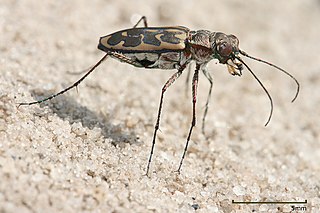
Tiger beetles are a family of beetles, Cicindelidae, known for their aggressive predatory habits and running speed. The fastest known species of tiger beetle, Rivacindela hudsoni, can run at a speed of 9 km/h, or about 125 body lengths per second. As of 2005, about 2,600 species and subspecies were known, with the richest diversity in the Oriental (Indo-Malayan) region, followed by the Neotropics. While historically treated as a subfamily of ground beetles (Carabidae) under the name Cicindelinae, several studies since 2020 indicated that they should be treated as a family, the Cicindelidae, which are a sister group to Carabidae within the Adephaga.

Ground beetles are a large, cosmopolitan family of beetles, the Carabidae, with more than 40,000 species worldwide, around 2,000 of which are found in North America and 2,700 in Europe. As of 2015, it is one of the 10 most species-rich animal families. They belong to the Adephaga. Members of the family are primarily carnivorous, but some members are phytophagous or omnivorous.

Cicindela, commonly known as common tiger beetles are generally brightly colored and metallic beetles, often with some sort of patterning of ivory or cream-colored markings. They are most abundant and diverse in habitats very often near bodies of water with sandy or occasionally clay soils; they can be found along rivers, sea and lake shores, sand dunes, around dry lakebeds, on clay banks, or woodland paths.
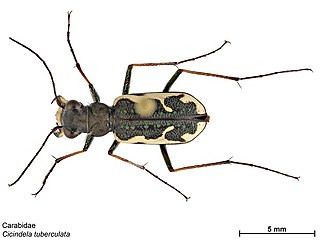
Neocicindela tuberculata is a species of tiger beetle in the subfamily Cicindelinae of the family Carabidae, endemic to New Zealand. Its common names include common tiger beetle, moeone, and papapa, and in its laval stage penny doctor, butcher boy, kapuku, kui, kurikuri, moeone, and muremure. Neocicindela tuberculata was the first carabid beetle described from New Zealand. The species can run as fast as 5 miles per hour and are considered to be the fastest running beetles. Adult species prefer clay banks in summer and are good predators when in comes to insects.

Cicindela aurofasciata is a species of tiger beetle endemic to India. It usually occurs in open grass dominated habitats and varies in size between 12 and 14 mm long. It is closely related to Cicindela goryi which was treated as a subspecies.

Cylindera is a genus of ground beetles native to the Palearctic, the Near East and northern Africa. It was a result of the breakup of the Cicindela genus, and the status of Cylindera as a genus or a subgenus of the genus Cicindela is in dispute.
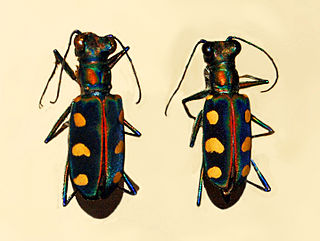
Cicindela aurulenta, common name blue-spotted or golden-spotted tiger beetle, is a beetle of the family Carabidae.
Iresia psyche is a species of tiger beetle in the genus Iresia.
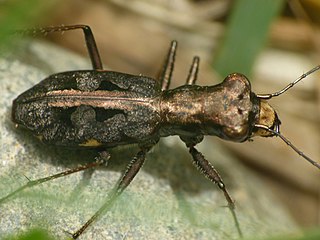
Cylindera dromicoides is a species of ground beetle of the subfamily Cicindelinae. It is flightless and has been found mainly along the Himalayas from India through Nepal and Bhutan and in the Chinese province of Yunnan.
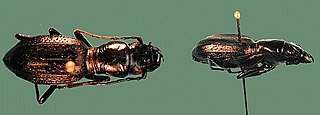
Amblycheila schwarzi, also known as the Mojave giant tiger beetle, is a flightless and nocturnal tiger beetle species found in the southern United States. A. schwarzi was first described by German entomologist Walther Horn in 1904.

Ellipsoptera cuprascens, the coppery tiger beetle, is a species of flashy tiger beetle in the family Carabidae. It is found in North America.
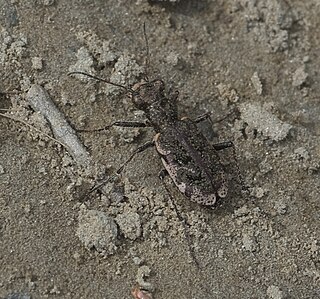
Neocicindela garnerae, the South island tiger beetle (native) (NZ), is a species of tiger beetle in the family Carabidae.

Megacephalini is a tribe of big-headed tiger beetles in the family Carabidae.

Rivacindela hudsoni is an Australian species of the family Cicindelinae or "tiger beetle" and is the fastest-running known insect. The genus Rivacindela is contentiously treated as a subgenus of the broader Cicindela and are typically found in saline habitats such as dry salt lakes and salt streams and are flightless. The species was discovered in South Australia and described in 1997, with an adult form of approximately 20–21mm in length and a running speed of 2.49m/s, or 120 body lengths per second. The comprehensive phylogeny that defines the Rivacindela hudsoni is as follows: Animalia, Arthropoda, Insecta, Coleoptera, Carabidae, Cicindelinae, Rivacindela, Rivacindela hudsoni.

Cosmodela duponti is a species of tiger beetle with wide distribution range in South and Southeast Asia. They are found mainly in forested habitats.

Jansenia venus is a species of tiger beetle endemic to the Western Ghats of India. It is found mainly in the summer from May to June inside forest cover. It forages on the ground inside forest but when disturbed it flies and perches on vegetation.
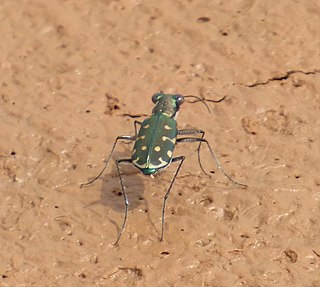
Myriochila distinguenda is a species of tiger beetle found in South Asia. It is found mainly on the muddy shoreline around freshwater. The genus Myriochila is characterized by hooked setae on the femora and four hairs on the pale or whitish labrum.
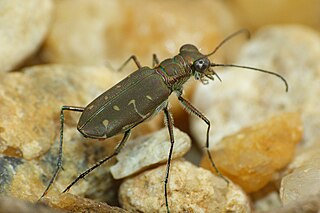
Calomera fowleri is a species of tiger beetle endemic to peninsular India. It is found foraging on wet sand and riverine areas in the edges of forests. It is somewhat similar to Calomera angulata but that species is found on open sandy beaches, has bolder markings and longer mandibles.
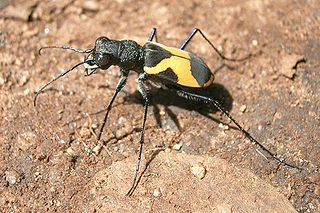
Cicindela goryi is a species of tiger beetle from southern India. It was earlier treated as a subspecies of the closely related Cicindela aurofasciata.



















